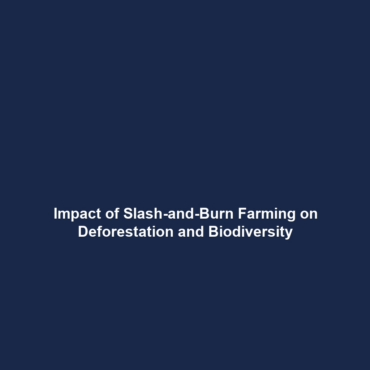How Slash-and-Burn Farming Techniques are Used in Tropical Regions to Clear Land for Crops
Introduction: Slash-and-burn farming is a traditional agricultural practice prevalent in tropical regions, where forested areas are cleared by cutting down vegetation and burning the debris to create arable land. This method, while effective for short-term agricultural productivity, poses significant threats to biodiversity and contributes to widespread deforestation. Understanding the mechanisms and implications of slash-and-burn techniques is essential as they serve as a critical factor in the ongoing crisis of habitat loss and species extinction.
Key Concepts
Slash-and-burn farming, often linked with subsistence agriculture, relies on the cyclical process of:
- Land Clearing: Farmers clear a plot of land by cutting down trees and shrubs.
- Burning: The cleared vegetation is burned, which enriches the soil with nutrients through ash, providing a fertile bed for crops.
- Cultivation: Crops are planted for a few growing seasons before the land is abandoned due to declining soil fertility.
- Regeneration: The abandoned land is left to regenerate, but often, the cycle begins anew as more forest is cleared.
These practices contribute to Deforestation and Biodiversity Loss as they disrupt ecosystems, leading to reduced flora and fauna diversity in affected areas.
Applications and Real-World Uses
Slash-and-burn farming has practical applications in several regions:
- Subsistence Farming: It allows local communities to cultivate food crops effectively in nutrient-poor tropical soils.
- Cash Crop Production: Farmers often use this method to clear land for cash crops such as coffee, cocoa, and palm oil.
- Forest Management: Occasionally, it is used in controlled forest management to promote regrowth of certain species.
The applications of slash-and-burn farming demonstrate its role in economic sustenance yet highlight the need for sustainable practices to mitigate its impacts related to Deforestation & Biodiversity Loss.
Current Challenges
Despite its applications, there are significant challenges in managing slash-and-burn techniques:
- Environmental Degradation: Rapid land clearing leads to diminished forest cover and loss of biodiversity.
- Carbon Emissions: Burning organic matter contributes significantly to carbon dioxide emissions, exacerbating climate change.
- Soil Erosion: The method often results in soil erosion and degradation over time, rendering land useless for future farming.
- Cultural Resistance: Implementing alternative practices meets resistance from local communities reliant on traditional methods.
Future Research and Innovations
The future of slash-and-burn practices in relation to Deforestation & Biodiversity Loss may be shaped by:
- Sustainable Alternatives: Research into agroforestry practices that integrate trees and crops could provide a sustainable pathway.
- Technology Integration: Advances in agriculture technology may yield precision farming methods that reduce the need for land clearing.
- Policy Development: Enhanced policies can promote sustainable land use and conservation strategies addressing the root causes of deforestation.
Conclusion
In summary, while slash-and-burn farming techniques facilitate immediate agricultural needs in tropical regions, they significantly contribute to Deforestation and Biodiversity Loss. Understanding and mitigating these impacts is essential for sustainable farming practices. A collective effort is needed to look into innovative solutions and adopt policies that preserve ecosystems while meeting the food demands of local communities. For further reading on sustainable farming methods and their role in preserving biodiversity, please explore our related articles.
